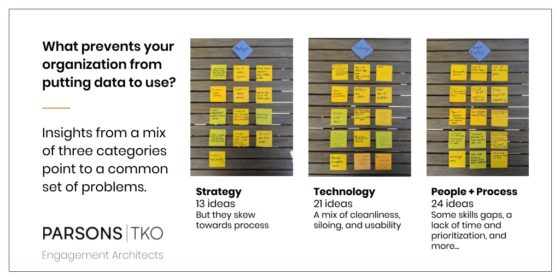Last week I had the pleasure of presenting—nay, of hosting a collaborative learning session—with the Oakland Nonprofit Technology Network (NTEN) about the challenges and opportunities of putting data to work at nonprofit organizations. My co-panelists, Sarah Vig from the Sierra Club and Sarah Wunning from GLIDE SF, shared stories about how to gradually enhance data capabilities with incremental enhancements towards a vision for data integration and reporting, as well as how to make use of skills-based volunteers, including data specialists.
A central theme of our conversation, however, was that good ideas can come from anywhere, and indeed your audience often is your best resource for figure out what your audience needs. To that end, we ran a quick (2 minute) group exercise where everyone in attendance wrote down their answers to a simple question: What is preventing your organization from successfully putting its data to use?
We then quickly categorized these ideas into 3 categories: Strategy problems, technology problems, and people/process problems.

This 2-minute exercise resulted in an explosion of more than 50 ideas, and the process itself demonstrated a host of fascinating and endemic challenges to working with data, including data cleanliness, digitizing offline data, and enforcing categorization in the face of “gray areas”.
Here are the answers we received, roughly broken down into three categories.
Strategic problems that keep organizations for using their data to advance the goals of an organization:
- not looking at trends: focus on now instead of using the past to predict future
- need to define objectives
- cultural barriers – how do we create a culture of data
- building data culture
- fixation on vanity metrics
- need to step out of the “dream space”
- senior management understanding + desire
- having the time to routinely consume + consider data and implications
- reporting, analytics
- focus on anything that can be counted rather than relevance
- knowing what specific actions in the future can raise or lower a metric
- silo-ing of data btwn teams
- it isn’t a high priority
Technology problems that keep your data locked away or otherwise difficult to use:
- tools
- historical data is a mess
- poor system setup
- poor adoption
- lack of understanding by key constituents/stakeholders
- data silos -multiple data sources – where is the source of truth?
- not all in one place
- data collection + cleanliness
- no easy tools to visualize
- not having the data thoughtfully organized
- having incomplete data
- silos time skill
- need software & training on that software so
- time to implement.
- clean existing data to get ready
- ensuring the data systems are set up correctly (example: google analytics) capacity to put learnings in place.
- accessible platforms for delivery
- how to use data from one system in another system
- missing / incomplete data
- data stored in different places
- salesforce dashboards have limitations and are not very attractive
People and process challenges that keep organizations from taking advantage otherwise “ready” data:
- lack of cross – team communication
- bandwidth resources
- lack of data measurable goals
- lack of salesforce expertise on the development team
- staff power
- conflicting priorities
- time
- expertise
- understanding
- lack of resources (human)
- variable priorities
- staff time capacity
- systems in place
- no pause and debrief + share pieces with relevant teams.
- lack of process documentation (garbage in garbage out)
- end user comfort w/ using data to get insights
- inconsistent definitions of what responses/ data mean
- bureaucratic decision processes
- challenging high speed technology needs
- “slow vs faster” – process vs needs
- not enough time
- need more technical people with more experience
- lack of capacity
- institutional weight with data.
These three categories are central to ParsonsTKO’s data strategy support for our clients, and simply scanning the list reinforces three key points to our approach:
- More than any piece of technology or aspect of digital strategy, what keeps most organizations from successfully using their data is a question of time, talent, and a culture of analytics. Unless you focus on the people and process of your organization, your data will never make a difference.
- Data integration, cleanliness, and other factors that can be summed up as the “data readiness” of your organization are key accelerants for your use of data, making it easier for staff to “get involved” and making the insights you draw from your data more relevant.
- Creating goal-oriented metrics, or “impact metrics” is crucial to help connect your data to the day-to-day work of your organization. This relevance is what keeps staff engaged and ensures that your data is helping to shape decisions and improve the outcomes of your work.
This kind of stakeholder engagement and interinstitutional learning are a big part of the work we do at ParsonsTKO, and we hope to continue collecting ideas like this from our community. As we go, we’ll continue analyzing these ideas and sharing ideas about how to address each challenge. Follow me on Twitter or connect with me on LinkedIn to catch the latest as we continue to help organizations large and small to succeed with data!
#nonprofit organizations can learn so much from one another. Last week, I gathered with #nptechoakland (#nptech) to hear what’s keeping local orgs from being effective with data. So many ideas! I am going solve each of these challenges now.https://t.co/ES9IYtXm2H
— Stefan Byrd-Krueger (@byrdkrueger) April 30, 2019





